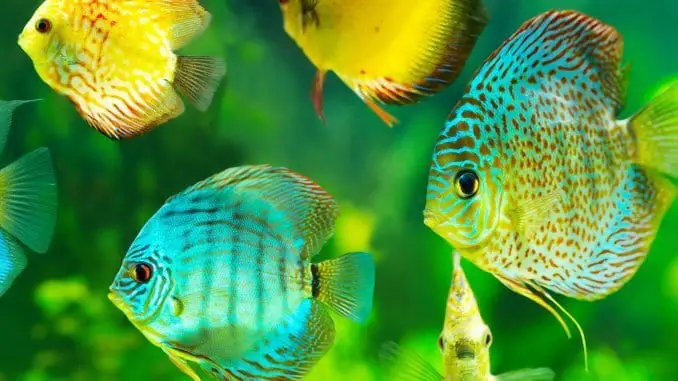
The discus fish (or Symphysodon) is a freshwater fish of the cichlid genus. The fish’s common name is derived from its flattened shape.
Unlike many cichlids, the discus thrives in groups, is generally calm, and tends to be shy with other species. Brightly colored and often intricately patterned, the discus fish is typically between 4.8–6.0 inches in length.
Although discus fish can be challenging to keep, especially in a mixed tank, enthusiasts prize the fish for their striking appearance and incredible ability to change color.
TABLE OF CONTENTS
Discus Fish Facts & Overview
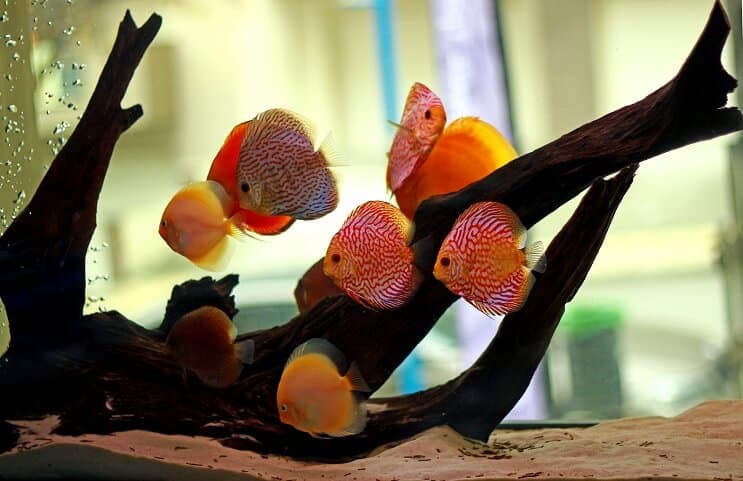
| Scientific name: | Symphysodon aequifasciatus (blue discus or brown discus), S. discus (red discus or heckle discus), S. tarzoo (green discus) |
| Common names | Discus fish, pompadour fish, king of the aquarium |
| Distribution: | Amazon river basin, South America |
| Size: | 4.6–8 inches |
| Life expectancy: | 10–15 years in captivity |
| Color: | Wild discus fish are red, blue, or green, and other colors. Patterned hybrids exist in captivity |
| Diet: | Omnivore |
| Temperament: | Intelligent, peaceful, shy |
| Minimum tank size: | 10 gallons per fish, or over 55 gallons for a group of six fish |
| Temperature: | 82–88°F (28–31°C) |
| pH: | 6.0–7.0 |
| Hardness: | Soft water, 2–8 dGH |
| Care level: | Challenging, requires a higher temperature than many other species |
| Breeding: | Mouthbrooders |
Origin
The discus fish is native to the Amazon river in South America. The blue discus is native to the eastern Amazon basin, the green discus is native to the western Amazon basin, and the red discus is native to the Rio Negro area.
This species is challenging to keep in a mixed-species tank due to the discus fish’s low pH, high mineral content, and warm temperature needs. Captive discus fish have more vibrant colors when water parameters are well-maintained, even though the fish adapt better than wild species to water fluctuations.
Decorate the discus fish’s tank with driftwood to replicate the fallen trees in branches found in the species’ native habitat.
Habitat loss and other environmental changes may present a long-term threat to the discus species in the wild.
Adult Size & Lifespan
In the wild, adult discus fish typically reach 4.8–6 inches in length. However, in captivity, they can reach up to 9 inches long. Male discus fish are slightly larger than females.
In captivity, discus fish can live between 10–15 years. Their lifespan is often shorter in the wild due to predators.
Availability
Discus fish are a specialty breed, so they’re not often available in local stores, and if you find these fish locally, they may not be high-quality specimens.
These fish are best bought in groups from specialty breeders online. Reputable breeders include Discus Madness, LiveAquaria, and Petco, and the fish range from $60 to $240 per specimen.
Appearance & Behavior
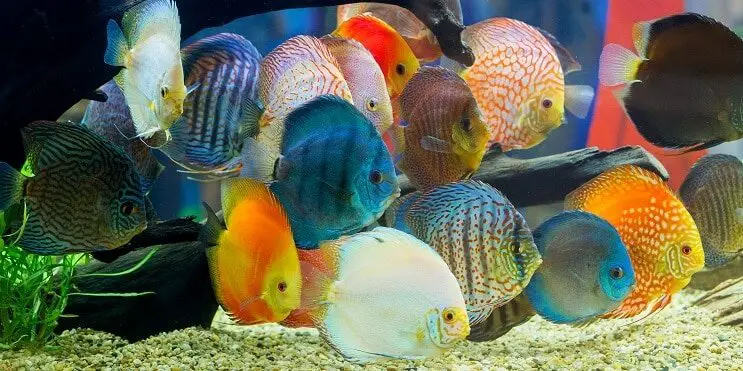
Discus fish get along well with other species, but keeping a mixed-species tank with discus can be challenging because the fish has strict tank condition requirements. A group of discus fish makes an attractive addition to any aquarium due to the fish’s flat, rounded shape and vibrant coloring.
Colors, Patterns, Fins, and Sex Differences
Discus fish have four primary jewel-like colors and the fish display a variety of markings and patterns, which enthusiasts highly prize. Heckle discus are typically pale yellow with three vertical stripes of the same color, with one stripe running through the eye. Brown discus have nine vertical stripes, while blue and green discus have red dots.
Many of the more brightly marked discus variations result from hybridization and don’t exist in the wild. Complete coloring emerges as the fish matures, and the fish change color according to their environment and other factors.
Bright colors and vivid markings on specimens under 2 inches long may result from hormone supplementation, and if this is the case, the colors fade over time.
While the discus fish’s flat sides and rounded shape give the species some resemblance to angelfish, discus fish lack the angel fish’s characteristic extended fins.
Typical Behavior
Discus are peace-loving fish that thrive when they can swim slowly around an aquarium in a group. When intimidated by larger, faster, or more aggressive fish, discus tend to hide in plants or caves. Discus fish are active in the day and sleep at night.
Like other cichlids, discus fish can be territorial, so it’s best to keep them with other fish of a similar size. Slow-swimming fish that don’t compete for food make good tank mates for discus fish.
Discus Fish Care & Tank Requirements
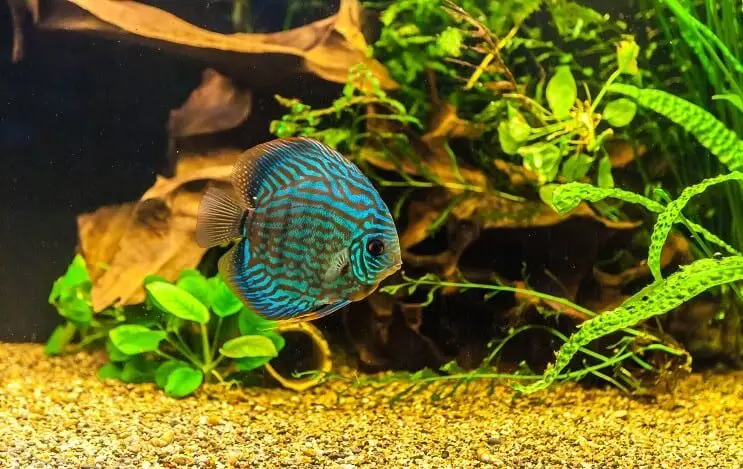
Discus fish are considered a specialty breed. Caring for them is challenging because these fish have specific tank and diet needs.
Habitat and Tank Requirements
The discus fish inhabits the slow-moving rivers and lakes of the lowland Amazon basin. The fish congregate close to fallen trees and branches near river banks in the wild, so in captivity, discus prefer stable environments.
| Water type: | Soft, freshwater |
| Tank size: | Minimum 60 gallons (10 gallons per discus fish) |
| Water temperature: | 82–88°F (28–31°C) |
| Substrate: | Sand, pebbles, rocks |
| Tank setup: | Plants, caves, driftwood |
| Acidity: | 6.0–7.0 pH |
| Water hardness: | 6–14 dGH |
| Filter: | Yes, discus fish produce a large amount of waste and stir up the substrate, so a sturdy filter is essential |
| Plants: | Yes, to circulate the water in the aquarium and ensure an adequate oxygen supply. In larger tanks, powerheads (submersible pumps) are preferred |
Discus fish bought online can be added directly to a prepared tank. A newly added fish that lies on its side is not ill or dying — this is a normal reaction to the change in water pressure between the container and the aquarium, and the fish will soon acclimatize.
Change 10% to 25% of the discus fish tank water weekly to maintain good water quality.
Disease
Discus fish are most vulnerable to common warm-water bacterial infections such as cotton wool and hole-in-the-head disease. The fish are also prone to internal and external parasite infections such as gill flukes.
If the discus fish’s high water temperature requirements aren’t followed, the fish may be affected by common cool-water parasites and illnesses like ich (white spot disease).
Keeping your discus healthy includes keeping the tank clean, maintaining the water temperature at the correct level, and feeding the fish clean, high-quality food. As soon as you see any signs of illness, identify the cause then treat your fish quickly and carefully.
Tank Mates
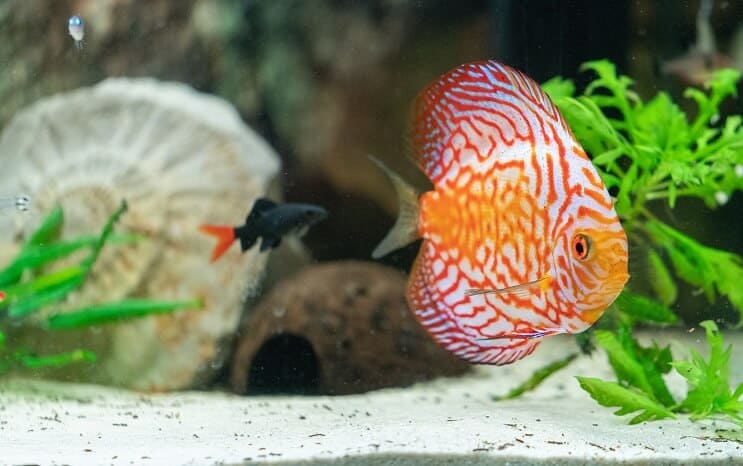
Suitable tank mates for discus fish include non-aggressive, slow-moving, large fish that require similar tank conditions as discus fish, and that aren’t small enough to be mistaken for food.
Great tank mates for discus fish include:
- Cardinal tetras
- Neon tetras
- Glowlight tetras
- Hatchetfish
- Sterbai cory catfish
- Plecostomus catfish
- Clown loaches
Tank mates to avoid include:
Diet and Feeding
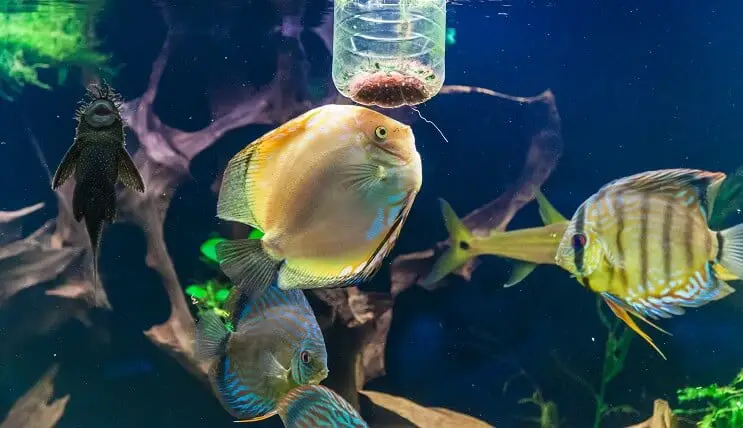
Discus fish feed mainly on aquatic insects, invertebrates, and plankton in the wild. Given their flattened body shape, discus can’t gorge on large meals, so they eat small portions throughout the day. It’s important to not overfeed the fish.
Captive discus fish need a varied diet of cichlid food, supplemented with protein-rich, live, freeze-dried or frozen foods. To develop the most vibrant colors, feed shrimp eggs or specialty pigment-enhancing foods.
Breeding
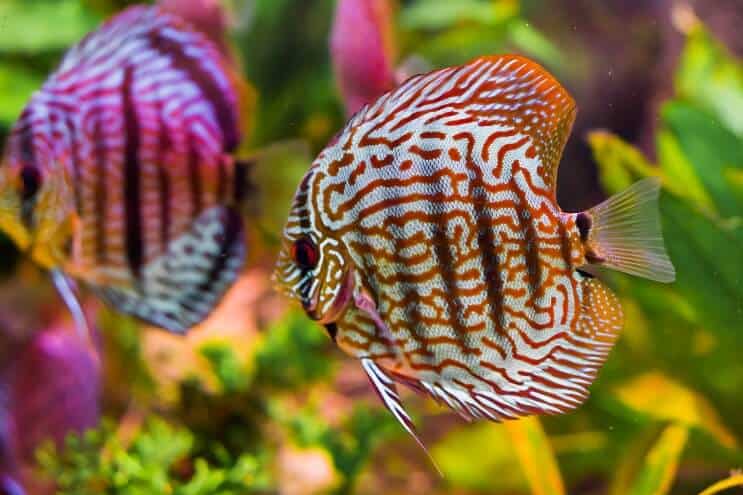
Identifying a discus breeding pair is challenging. Male and female discus both take two to three years to reach sexual maturity, and there’s no discernible difference between the sexes.
When you notice that two of your group appear territorial, transfer them to a breeding tank of at least 36 x 18 x 18 inches. Ensure that the water conditions, temperature, and food are all optimal. The bottom of the breeding tank should be bare for easy cleaning. Add driftwood and flat rocks to serve as egg-laying surfaces.
Encourage the discus to lay eggs by placing an upturned clay pot or plastic cone in the tank, providing the hard surface they need.
Gestation takes less than four days and is followed by an incubation period of 10 days. The discus young, which initially feed off the mucus on the parents’ scales, become independent after two to three weeks.
Should You Get a Discus Fish for Your Aquarium?
Discus fish should be kept in a group. Discus have specific requirements that can make them challenging to include in a mixed-species tank, and the fish require extensive time and attention to stay healthy.
However, with adequate space, suitable water conditions, and compatible tank mates, a group of discus fish will add a splash of brilliant color and interest to your freshwater aquarium.

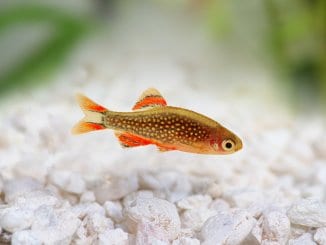
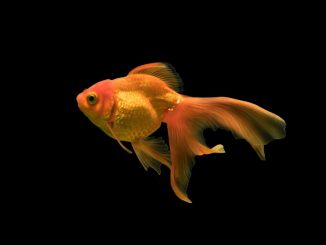
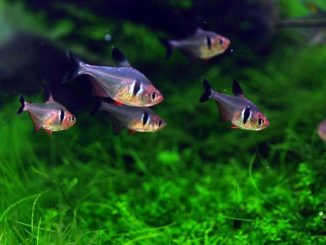
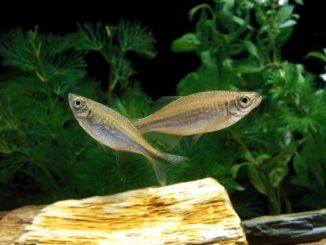
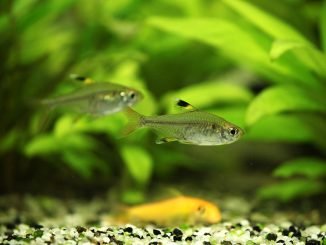
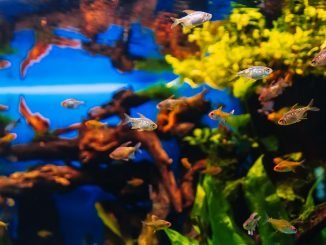
Loved your article I’m going to be setting up 180 gallon first time with discus fish the more I know would be better any help is great. Do you know were I can get a book on them thank you.
Hey, Rob, thanks for the write up on Discus, I agree the are challenging but not too difficult to keep, they are however beautiful, i am still try to grasp food, feeding patterns i know they eat so but they are picky. i have a 220 gallon with about 21 discus and 2 Angels, the Discus between 6 – 8″ and the Angel are 4″ in body not fin to fin, they grew together.
I raised Dicus for years and just loved it, I also breed them as well, it’s extremely rewarding. I used a clean bottom tank w plants tied to drift wood. My tanks always looked amazing! I had 2-180, 2- 60, and 6-20 breeding tanks!
how many discus fish can i keep in a 55 gal tank with one angel fish, tow small peaceful chiclid, and some tetras??
no chiclid is too agressive